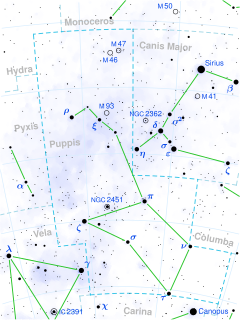
| |
| Observation data Epoch J2000 Equinox J2000 | |
|---|---|
| Constellation | Puppis |
| Right ascension | 07 49 17.65567 |
| Declination | −24° 51′ 35.2305″ |
| Apparent magnitude (V) | 3.35 |
| Characteristics | |
| Spectral type | G6 Iab-Ib |
| U−B color index | +1.18 |
| B−V color index | +1.25 |
| Astrometry | |
| Radial velocity (Rv) | +2.7 km/s |
| Proper motion (μ) | RA: −4.81 mas/yr Dec.: −0.89 mas/yr |
| Parallax (π) | 2.72 ± 0.21 mas |
| Distance | 1,200 ± 90 ly (370 ± 30 pc) |
| Absolute magnitude (MV) | –3.89 |
| Details | |
| Mass | 9.9 ± 1.0 M☉ |
| Radius | 124 R☉ |
| Luminosity | 6,824±641 L☉ |
| Surface gravity (log g) | 1.21±0.14 cgs |
| Temperature | 4,712±125, 4,925 K |
| Metallicity | +0.13 dex |
| Rotational velocity (v sin i) | 9.2 km/s |
| Age | 23 Myr |
| Other designations | |
| Azmidi, Azmidiske, Asmidiske, ξ Puppis, ξ Pup, Xi Pup, 7 Puppis, CCDM J07493-2452A; CPD−24 2939, FK5 1204, GC 10562, HD 63700, HIP 38170, HR 3045, IDS 07451-2437 A, PPM 253258, SAO 174601, WDS J07493-2452A. | |
| Database references | |
| SIMBAD | data |
Xi Puppis (ξ Puppis, abbreviated Xi Pup, ξ Pup) is a multiple star system in the southern constellation of Puppis. With an apparent visual magnitude of 3.35, it is one of the brighter members of this constellation. Based on parallax measurements made during the Hipparcos mission, it is located approximately 1,200 light-years (370 parsecs) from the Sun, with a 7.5% margin of error.
The system consists of a spectroscopic binary, designated Xi Puppis A, together with a third companion star, Xi Puppis B. A's two components are themselves designated Xi Puppis Aa (formally named Azmidi /ˈæzmɪdi/) and Ab.
Nomenclature
ξ Puppis (Latinised to Xi Puppis) is the system's Bayer designation. The designations of the two constituents as Xi Puppis A and B, and those of A's components - Xi Puppis Aa and Ab - derive from the convention used by the Washington Multiplicity Catalog (WMC) for multiple star systems, and adopted by the International Astronomical Union (IAU).
The system was sometimes known as Asmidiske (Azmidiske), a misspelling and misplacement of Aspidiske (from the Greek for 'little shield), the traditional name of Iota Carinae. In 2016, the IAU organized a Working Group on Star Names (WGSN) to catalog and standardize proper names for stars. The WGSN decided to attribute proper names to individual stars rather than entire multiple systems. It approved the name Azmidi for the component Xi Puppis Aa on 1 June 2018 and it is now so included in the List of IAU-approved Star Names.
Properties
Because of the distance of this system from the Earth, its visual magnitude is reduced by 0.73 as a result of extinction from the intervening gas and dust.
Xi Puppis A presents as a yellow supergiant of spectral class G6 with a luminosity 8,300 times that of the Sun.
The 13th-magnitude companion, Xi Puppis B, is about 5 arcseconds distant and is a Sun-like star that orbits at least 2000 AU away with an orbital period of at least 26,000 years.
References
- ^ van Leeuwen, F. (November 2007), "Validation of the new Hipparcos reduction", Astronomy and Astrophysics, 474 (2): 653–664, arXiv:0708.1752, Bibcode:2007A&A...474..653V, doi:10.1051/0004-6361:20078357, S2CID 18759600
- ^ Johnson, H. L.; et al. (1966), "UBVRIJKL photometry of the bright stars", Communications of the Lunar and Planetary Laboratory, 4 (99): 99, Bibcode:1966CoLPL...4...99J
- ^ Lyubimkov, Leonid S.; et al. (February 2010), "Accurate fundamental parameters for A-, F- and G-type Supergiants in the solar neighbourhood", Monthly Notices of the Royal Astronomical Society, 402 (2): 1369–1379, arXiv:0911.1335, Bibcode:2010MNRAS.402.1369L, doi:10.1111/j.1365-2966.2009.15979.x, S2CID 119096173
- Wilson, R. E. (1953). "General Catalogue of Stellar Radial Velocities". Carnegie Institute Washington D.C. Publication. Carnegie Institute of Washington D.C. Bibcode:1953GCRV..C......0W.
- ^ Luck, R. Earle (2014-06-01). "Parameters and Abundances in Luminous Stars". The Astronomical Journal. 147 (6): 137. Bibcode:2014AJ....147..137L. doi:10.1088/0004-6256/147/6/137. ISSN 0004-6256. Xi Puppis' database entry at VizieR.
- ^ McDonald, I.; Zijlstra, A. A.; Watson, R. A. (2017-10-01), "Fundamental parameters and infrared excesses of Tycho-Gaia stars", Monthly Notices of the Royal Astronomical Society, 471: 770–791, arXiv:1706.02208, Bibcode:2017MNRAS.471..770M, doi:10.1093/mnras/stx1433, ISSN 0035-8711 Xi Puppis' database entry at VizieR.
- De Medeiros, J. R.; Udry, S.; Burki, G.; Mayor, M. (2002). "A catalog of rotational and radial velocities for evolved stars. II. Ib supergiant stars". Astronomy and Astrophysics. 395: 97–98. arXiv:1312.3474. Bibcode:2002A&A...395...97D. doi:10.1051/0004-6361:20021214.
- "Washington Double Star Catalog". United States Naval Observatory. Retrieved 20 June 2018.
- ^ "Naming Stars". IAU.org. Retrieved 18 June 2018.
- Hessman, F. V.; Dhillon, V. S.; Winget, D. E.; Schreiber, M. R.; Horne, K.; Marsh, T. R.; Guenther, E.; Schwope, A.; Heber, U. (2010). "On the naming convention used for multiple star systems and extrasolar planets". arXiv:1012.0707 .
- ^ Kaler, James B., "ASMIDISKE (Xi Puppis)", Stars, University of Illinois, retrieved 2018-06-20
- "IAU Working Group on Star Names (WGSN)". Retrieved 22 May 2016.
- "WG Triennial Report (2015-2018) - Star Names" (PDF). p. 5. Retrieved 2018-07-14.
- Luck, R. E. (May 1, 1982), "The chemical composition of late-type supergiants. IV - Homogeneous abundances and galactic metallicity trends", Astrophysical Journal, Part 1, 256: 177–188, Bibcode:1982ApJ...256..177L, doi:10.1086/159895